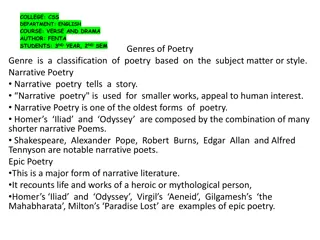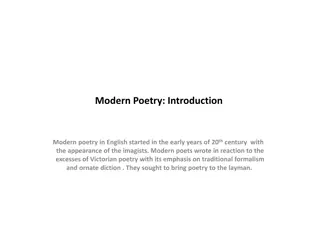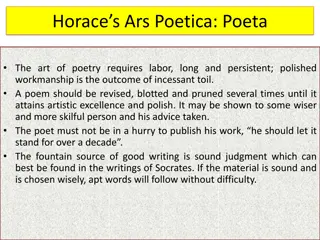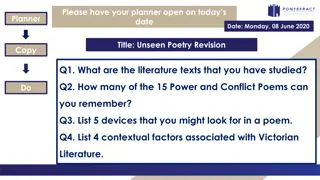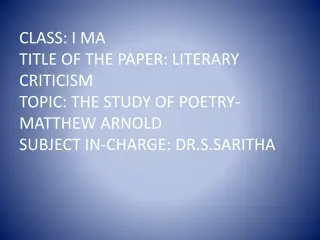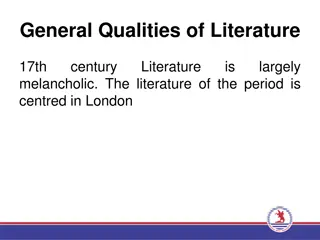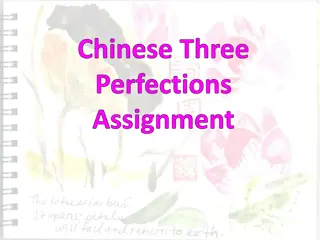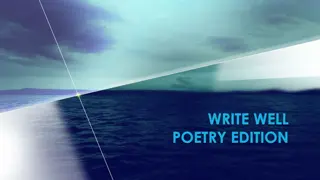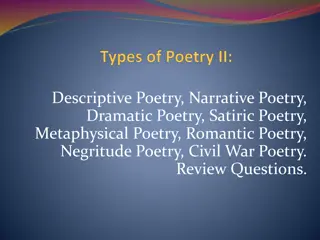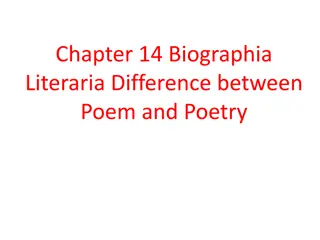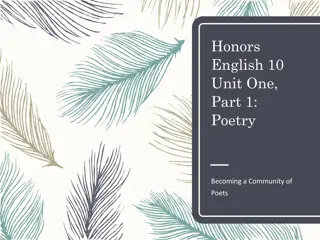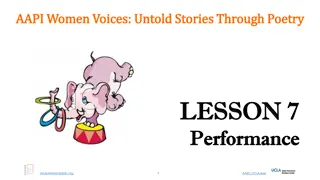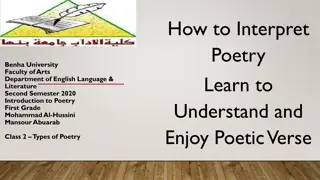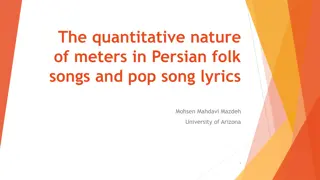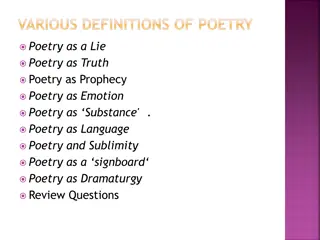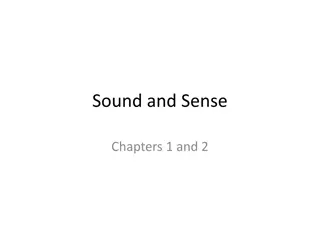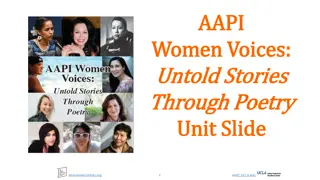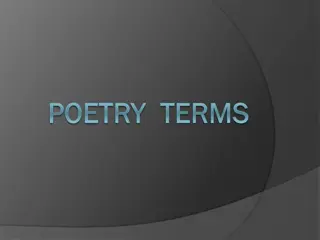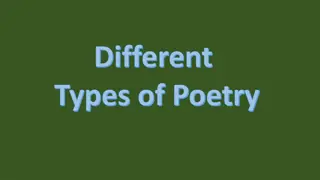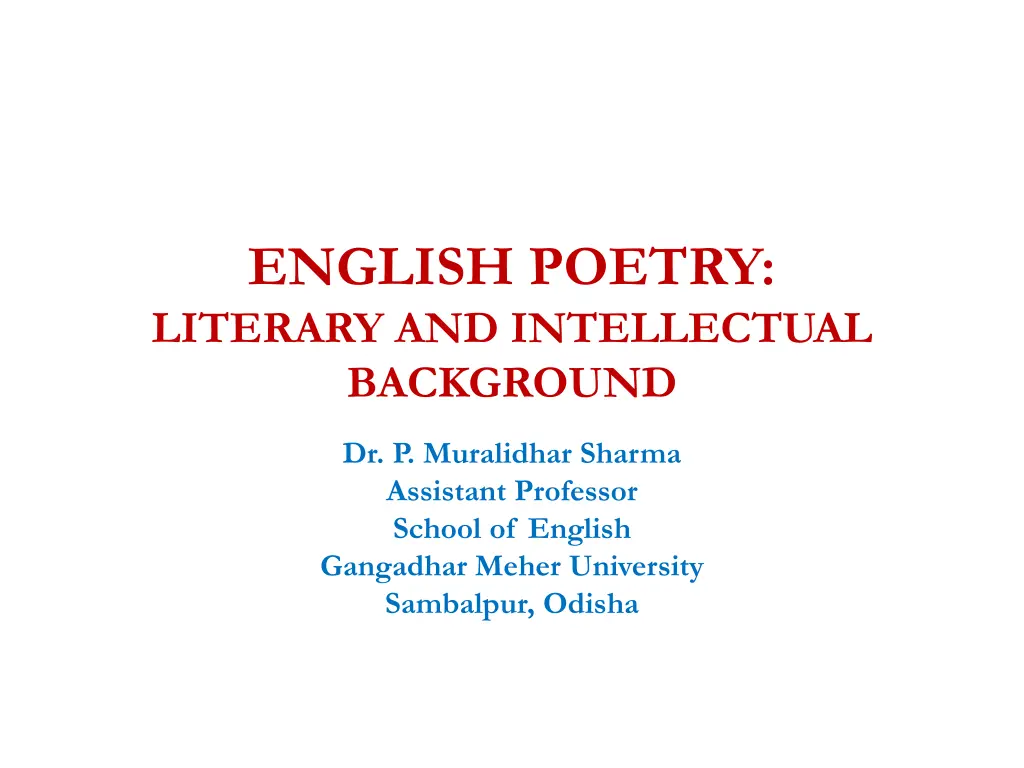
Evolution of English Poetry: Origins to Medieval Era
Delve into the rich literary and intellectual background of English poetry, from the oral verse narratives of the early Angles, Saxons, and Jutes to the emergence of medieval English poetry centered around Christian themes, heroic epics like Beowulf, and chivalric romances like Sir Gawain and the Green Knight. Explore the transition from pagan sagas to Christian verse, the intricacies of Old English manuscripts, and the diverse themes and styles that shaped the evolution of English poetry through the centuries.
Download Presentation

Please find below an Image/Link to download the presentation.
The content on the website is provided AS IS for your information and personal use only. It may not be sold, licensed, or shared on other websites without obtaining consent from the author. If you encounter any issues during the download, it is possible that the publisher has removed the file from their server.
You are allowed to download the files provided on this website for personal or commercial use, subject to the condition that they are used lawfully. All files are the property of their respective owners.
The content on the website is provided AS IS for your information and personal use only. It may not be sold, licensed, or shared on other websites without obtaining consent from the author.
E N D
Presentation Transcript
ENGLISH POETRY: LITERARY AND INTELLECTUAL BACKGROUND Dr. P. Muralidhar Sharma Assistant Professor School of English Gangadhar Meher University Sambalpur, Odisha
Old English Poetry Oral verse narratives of the Angles, Saxons, and the Jutes Caedmon: late 7thcentury Cynewulf: 9thcentury Verses inspired from scripture Predominantly Christian themes Hymn of Creation : only surviving poem Repository of commonly used poetic expressions Kennings: compounds replacing common nouns, i.e. whale-path or swan-road for sea or God s-beacon for Sun, and ring-giver for king
Manuscripts of Old English Verse Manuscripts dating back to 10thand 11thcenturies 1. Beowulf Manuscript: Beowulf, Judith, etc 2. Exeter Book: Riddles, religious and didactic verse 3. Junius Manuscript: Biblical verse 4. Vercelli Book: Saints lives, short religious verses Poems from the Anglo-Saxon Chronicle The Wanderer , The Seafarer , Deor : Elegiac lamentation, spiritual subject matter Anonymity and uncertain authorship Debates on dates of composition
Scandinavian saga Pagan, pre-Christian worldview Anonymous authorship Heroic poem Series of battles between Beowulf and the monster Grendel Defeat of Grendel by the eponymous hero Beowulf as a warrior-hero Epic-like in scope: grand scenes, massive action Disruption and restoration of order
Medieval English Poetry Continuation of earlier traditions Emergence of a literary culture that revolved around the Church Christian, religious verse and didactic verse Lazamon, Brut: epic conventions, traces the origin and evolution of English people, 16000 lines The Owl and the Nightingale: 12thcentury, anonymous, Latin tradition of debate poetry, overheard debate between the birds from the title Human attributes of the birds, intelligence, articulation, mutual abuse, charges and counter-charges
Sir Gawain and the Green Knight: 14thcentury, anonymous, alliterative poem, chivalric romance Knighthood: formal rituals, code of conduct, lonely quest, King Arthur s court as setting Pearl, Purity, Patience Chivalry as a poetic subject: a moral, religious and social code of Knightly and courtly conduct
Poetry in the Age of Chaucer Coexistence of imitative as well as strikingly original poetry Influence of French and Italian poetry on Chaucer The Book of the Duchess, Roman de la Rose Steady influence of the court on English poetry Familiarity with the work of Roman poets like Ovid and Italian poets like Dante, Petrarch, Boccaccio Recurrent use of the dream-vision sequence Use of wit, irony, and humour The Parliament of Fowls, Troilus and Criseyde
The Canterbury Tales: magnum opus Significant early poetic work in the vernacular Less imitative, more original poetic conventions Pilgrimage as the major motif Exchange of tales (24 in total), wily banter, humour A lively tableaux of 14thcentury English social arrangement Rank, hierarchical order Knight, Squire, Prioress, Monk, Merchant, Man of Law, Franklin, Miller, Reeve Pardoner, Wife of Bath Witty repartee, lively conversation, jovial company of pilgrims
Coexistence of the sacred and secular elements Use of varied generic conventions Courtly romance, chivalric tale, saints lives, beast fable, allegory Colloquial language Cataloguing of characters Moral concerns in Chaucer s poetry Social satire Detailing of individual character traits William Langland: Piers Plowman: Allegorical John Gower: Confessio Amantis, Vox Clamantis

